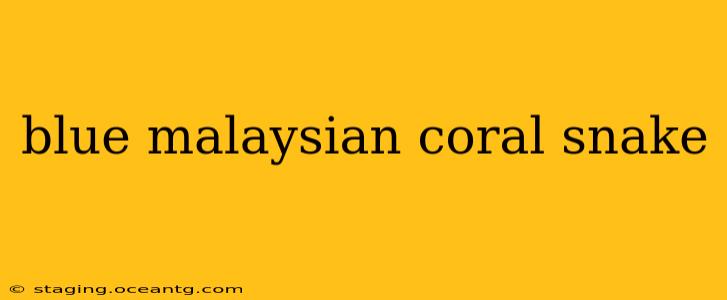The Blue Malaysian Coral Snake, scientifically known as Calliophis bivirgatus, is a species that captivates both herpetologists and nature enthusiasts alike. Its striking beauty, coupled with its venomous nature, makes it a subject of both fascination and caution. This comprehensive guide delves into the intricacies of this remarkable reptile, addressing common queries and providing in-depth information.
What is a Blue Malaysian Coral Snake?
The Blue Malaysian Coral Snake is a slender, highly venomous elapid snake found in Southeast Asia, primarily in Malaysia, Indonesia, and Thailand. Its vibrant coloration, typically featuring a deep blue or bluish-black body with bright red or orange rings, immediately distinguishes it from other snakes. These rings are often bordered with black, adding to its striking appearance. While beautiful, this coloration serves as a warning to potential predators – a potent example of aposematism. The snake's size is relatively modest, with adults rarely exceeding 1 meter in length.
Is the Blue Malaysian Coral Snake Poisonous?
Yes, the Blue Malaysian Coral Snake is highly venomous. Its venom is neurotoxic, affecting the nervous system. While bites are relatively rare due to the snake's shy and secretive nature, they can be extremely dangerous to humans if left untreated. Immediate medical attention is crucial following a bite. Antivenom is available in some regions, but access might be limited depending on location.
What Does a Blue Malaysian Coral Snake Eat?
These snakes are primarily ophiophagous, meaning their diet consists mainly of other snakes. They are ambush predators, patiently waiting for unsuspecting prey before striking with lightning speed. Smaller lizards and occasionally frogs may also form part of their diet, depending on availability. Their powerful venom effectively immobilizes their prey.
Where Do Blue Malaysian Coral Snakes Live?
Blue Malaysian Coral Snakes prefer humid, forested environments. They are often found in lowland rainforests and swamps, dwelling beneath leaf litter, logs, and in burrows. They are generally terrestrial, although they are capable of climbing. Their secretive nature makes them difficult to observe in the wild.
How Can I Tell the Difference Between a Blue Malaysian Coral Snake and Other Similar-Looking Snakes?
Differentiating the Blue Malaysian Coral Snake from other similar-looking species, particularly harmless mimics, requires careful observation. While color patterns can be helpful, variations exist within the species. Focusing on specific features like scale patterns, head shape, and overall body proportions is crucial. It's vital to emphasize that attempting identification solely based on photographs is risky. If unsure, it's best to assume the snake is venomous and maintain a safe distance. Expert herpetological identification is recommended in cases of doubt.
Are Blue Malaysian Coral Snakes Aggressive?
Blue Malaysian Coral Snakes are generally not aggressive. They tend to avoid confrontation and will typically flee when disturbed. However, like any venomous snake, they will bite if they feel threatened or cornered. Respecting their space and avoiding unnecessary handling is crucial to prevent bites.
How Dangerous Are Blue Malaysian Coral Snake Bites to Humans?
While not as aggressively venomous as some other elapids, a bite from a Blue Malaysian Coral Snake is still considered medically significant. Neurotoxic venom can cause severe symptoms, including paralysis, respiratory distress, and even death if untreated. The severity of the effects can depend on factors such as the amount of venom injected, the victim's health, and the time elapsed before treatment. Immediate medical attention is paramount.
What First Aid Should I Administer After a Blue Malaysian Coral Snake Bite?
The first priority after a Blue Malaysian Coral Snake bite is to seek immediate medical assistance. While waiting for professional help, keep the bitten area still and immobilized to slow the spread of venom. Avoid applying tourniquets or attempting to suck out the venom, as these methods can be harmful. Keep the victim calm and comfortable.
This in-depth exploration of the Blue Malaysian Coral Snake highlights the importance of appreciating its beauty from a safe distance. Its striking appearance and venomous nature serve as a reminder of the intricate balance within the rainforest ecosystem. Remember, always prioritize safety and seek professional help when dealing with venomous snakes.
